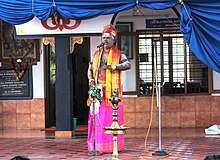Pathakam
Pathakam (Malayalam: പാഠകം, Sanskrit: पाठकम्) (also transliterated as Padakam, Padhakam, Patakam, Padakom, Paadakam, Paadhakam etc.) is a traditional temple art form of Kerala in which stories from Hindu Puranas are narrated .

Background
It is a bilingual art form in which a combination of Sanskrit and Malayalam are used. The language used in Pathakam is generally referred to as Semi-Sanskrit (Ardhasamskritam). The stage and costumes are very simple. Only a traditional lamp known as "Nilavilakku" is used in the stage, and there is no curtain. Costumes of the actor performing pathakam are very simple and is predominated by the red colour.[1] Performer apply thick lines of sandal paste across his forehead. Pathakam is traditionally performed by the Ambalavasi Nambiars. It is also performed by the Chakyar community. The art form is considered as a typical Keralite model of story telling.
History
This art form is believed to be originated from the Koothu. Traditionally, during the Koothu performance by Chakyar, the Mizhavu, a form of drum used in Koothu, is played by Ambalavasi Nambiars.[2] In earlier days, Koothu, in which a story is told continuously, was performed in temple from noon to evening. Once, Chakyar was unable to reach the temple for performing Koothu. After waiting for Chakyar for a long time, the Pothuval, who manages the temple matters, asked Nambiar whether he can perform the Koothu. Since, the Koothu is traditionally performed by the Chakyar community, Nambiar refused to perform Koothu.[3] However, on the compulsion of Pothuval, he agreed to tell the story in a simple form, without entering in the Koothamblam, the traditional stage for performing Koothu. Nambiar performed the story-telling outside the Koothambalam, in his own style, mixing Malayalam and Sanskrit languages, with simple costumes.[4] By the time of his performance, the Deeparadhana in that temple was over. In modern days also, Pathakam is performed only outside the Koothambalam, somewhere near Pradakshina Marga (പ്രദക്ഷിണവഴി), after Deeparadhana.
Gallery
- A Pathakam Performance from Koodal Manikyam Temple
 At Chirakkadavu Mahadeva Temple
At Chirakkadavu Mahadeva Temple
Reference
- "Pathakam Kerala Classical Art Form - Pathakam Folk Art Dance Form". Just Kerala. Retrieved 16 January 2018.
- "Padakam, the poor cousin of Chakyarkoothu - Times of India". The Times of India. Retrieved 16 January 2018.
- "Chakyar Koothu Kerala Traditional Dance - Chakyar Koothu Dance Form Kerala". Just Kerala. Retrieved 16 January 2018.
- Rani, Sandhya. "Kooth – An art form that connects with the audience - Boddunan". www.boddunan.com. Retrieved 16 January 2018.